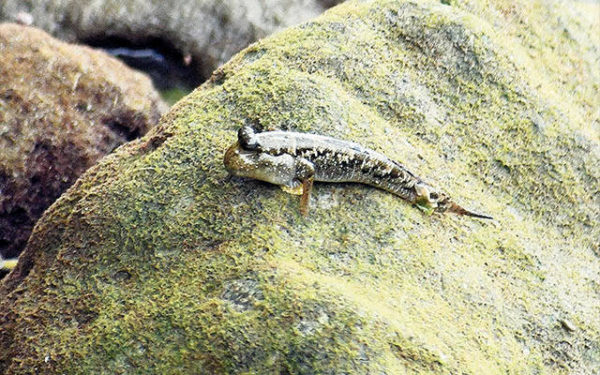Published in the Ocean Watch column, Honolulu Star-Advertiser © Susan Scott
March 10, 2018
Regarding Yap’s stone money, I wrote last week that the larger the piece, the more value it had. That’s wrong, according to two readers who informed me, kindly, that according to their Yapese friends, stone money is not valued by size.
Both readers explained that the value of a piece is determined by the number of men who died during its mining in, and transport from, Palau. Some of the oldest and smallest stones, therefore, are more valuable than the biggest ones, which were brought to Yap in Western-style sailing ships. Because no one died getting the giant disks, they’re worth less.
Speaking of small, another highlight of my trip was seeing the various gobies of Palau and Yap. Some were employed as sentries. Others traveled over land.
 A Palau mudskipper.
A Palau mudskipper.
©2018 Susan Scott
You might not notice gobies at first because they’re small, tend to duck for cover and then freeze. But these fish are everywhere. With about 2,000 species, gobies form the largest fish family in the world.
In Hawaii the four stream (freshwater) gobies are called oopu wai, and the 30 or so marine species are oopu kai.
One type, found both in Hawaii and in warm waters worldwide, sets up housekeeping with a nearly blind shrimp. The shrimp digs a burrow, but because its eyesight is so poor, it shares it with one or two alert gobies. With large, bulging eyes on top of their heads, gobies have sharp vision.
To avoid digging their own burrows, which some gobies do, shrimp gobies stand, single or in pairs, as lookouts for a sightless shrimp that spends its days bulldozing collapsing sand from its tunnel. As it works, the shrimp touches the goby’s tail with one long antennae. An approaching predator causes the goby to twitch its tail, and both fish and shrimp dive into the hole.
Startled gobies and their shrimp partners don’t stay down for long. After a few seconds they peek out and, if the coast is clear, resume digging and guarding.
It’s easy to spot these shrimp’s slanted burrows, a pile of sand and rubble next to a hole, usually with the shrimp bulldozing sand from below. The burrow is under constant construction.
During walks on both Palau and Yap, several of us noticed creatures leaping like tiny frogs among shoreline rocks. Upon close examination, however, we saw that the little hoppers weren’t frogs, but another kind of goby, called mudskippers in some parts of the world. Here in Hawaii we call our three species of air-and-water-breathing fish tide pool gobies, since they leap from pool to pool, somehow knowing where the next pool lies.
Shrimp gobies and mudskippers are about 2 inches long.
When it comes to riches in rocks and resourceful fish, small is good.
Thanks for writing.